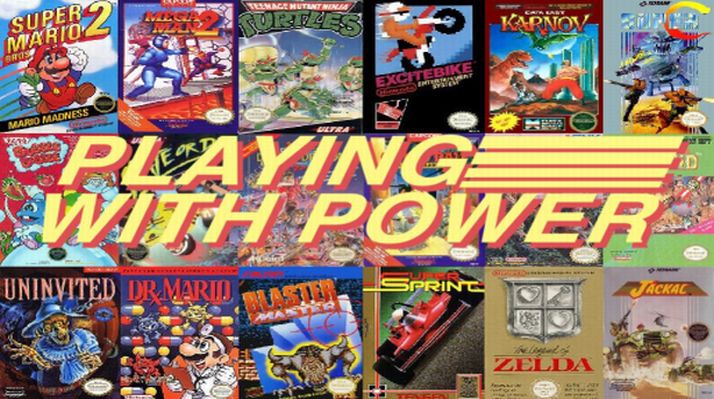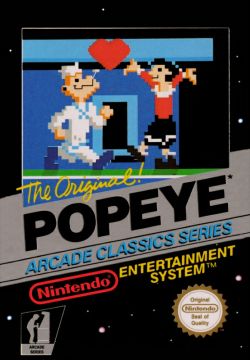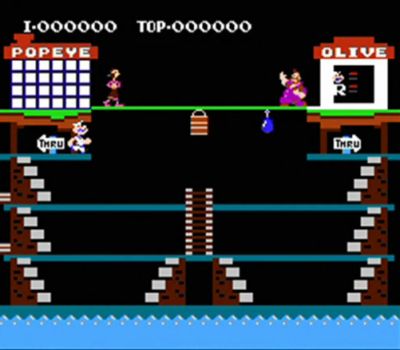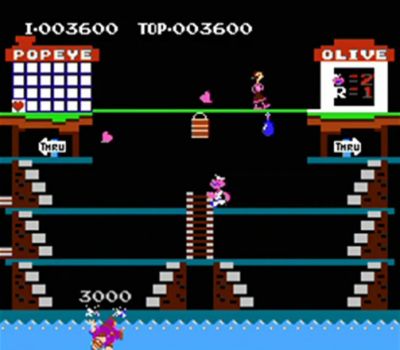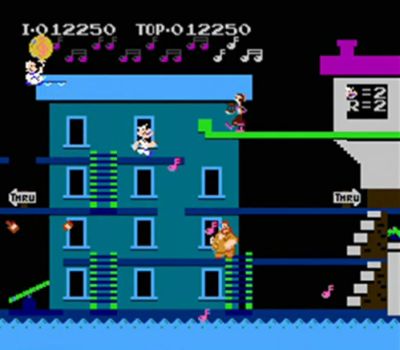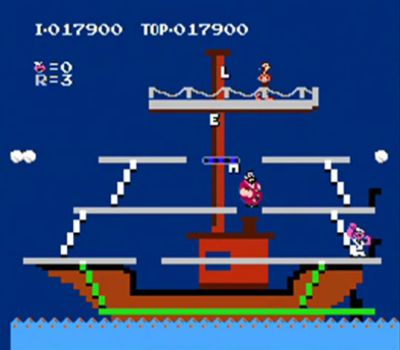Welcome to another edition of Playing With Power. The review article that looks at all things Nintendo Entertainment System. Well, Mega May has come and gone, and now it’s time to start looking at games that don’t star the iconic blue bomber. And for this week’s review, I figured it’s time to look at a game starring one of the oldest and most iconic heroes of all time, not to mention an arcade classic. It’s time to look at Popeye. Was this sailor man’s first foray into video games a winner? Or was it not able to hold water?
YEAR OF RELEASE: 1986
PUBLISHER: Nintendo
GENRE: Arcade Platformer
Popeye is one of the most iconic characters of all time. This lovable sailor saw his first appearance in 1929 as part of the comic strip Thimble Theatre. He started out as a mere side character, but his popularity more or less Urkeled him into becoming the comic’s main character. In 1933, Popeye would make a successful leap into the world of animation. His success as an animated character was so major that he would become the most popular character for several years, even being more popular than Mickey Mouse and Bugs Bunny.
Popeye would continue being a pop culture fixture throughout the century with many animated adaptations, toys, games, commercials, and even a live action movie in 1980 starring Robin Williams. It would only be a matter of time before Popeye would try to take on the realm of video games to prove his spinach chompin’ worth.
In 1980, Nintendo, still a struggling newcomer to the American video game market, would try to get the rights from King Features Syndicate to make a Popeye arcade game. However, their attempts would lead to failure as King Features had no interest. However, Shigeru Miyamoto would eventually take the ideas he had for the Popeye game and change them into another legendary Nintendo game called Donkey Kong (once stating that the relationship between Mario, DK and Pauline is very similar to Popeye, Bluto, and Olive Oyl).
Nintendo’s success with Donkey Kong was almost instantaneous, and eventually King Features Syndicate would see their way into giving the company the rights to produce a Popeye game. in 1982, Popeye would be released to the arcades, and would later see releases on the Atari 2600, the Colecovision, and the Magnavox Odyssey. In 1983, the game would be one of the first three games ported to Nintendo’s Famicom system, and in 1986, the game would see a port to the new Nintendo Entertainment System, in its Original Arcade Classic series alongside such games as Mario Brothers, Donkey Kong, and Donkey Kong Junior. How does the NES port hold up? Let’s find out.
COVER STORY
I love the black boxes. So vintage looking, and just gives you that warm feeling of the 80’s and all its gaming splendour. Plus I love the silver over the name, it’s just a far classier touch. It’s a definite eye pleaser, and if you’re a fan of retro art, you’ll love this too.
STORY
It’s a story that never ends. Popeye and Bluto (or Brutus if you prefer) once again vie for the love of the fair and lanky Olive Oyl. Popeye wants to win her heart once and for all, but has to deal with the brute Bluto, and other obstacles that stand in his way. With some luck, and some spinach, can the sailor man save the day?
GAMEPLAY
Popeye is an arcade game for one to two players. You control the titular sailor man as he has to survive three boards to win the love of Olive Oyl, while defeating Bluto, his long time rival. You control Popeye with the D-Pad to move left and right, climb stairs or ladders. The A button will have Popeye jump, while the B button executes a punch.
The object of the game is to collect all of the items that Olive Oyl drops. They will float from the top of the board to the bottom, where they will land in the water. If they stay in the water too long, they will disappear, and you will lose a life. Collecting them can be easy for the most part, but as the game progresses, they move faster and far more erratic.
The main obstacle in the game to deal with is Bluto. He will always give chase after you, and has a variety of tricks to take you out quick. First off, he can’t be hurt by you in any normal method, so touching him can lead to a death. He’ll throw beer bottles at you, but you can destroy them with punches. If you are a floor above him, he will jump at the ceiling and smack you. If you are a floor below him, he will often try to grab you, or jump down at you. Bluto can be a dastardly foe to deal with.
Luckily though, you do have a couple aces in the hole to put Bluto at bay. One that you get in a level of the game, and the other is spinach. Each level will have a can of spinach you can grab. If you are at all familiar with the legendary sailor man, you know that any time Popeye eats his spinach, he becomes an unstoppable powerhouse. run into Bluto, and you’ll send him flying into the water below. It’s very temporary, but it helps massively. It will also stop all of Olive’s items, making some easier to collect than others.
The game is broken into three boards. The first board will have Olive Oyl drop hearts that you have to collect to make a heart around her. the area is broken into four floors, and at the top is a barrel you can punch to keep Bluto incapacitated for a brief amount of time. The second board has you in a city area, where you have to catch the music notes Olive drops. You can use a platform to shoot you back to the top area, and hitting Sweet Pea on his balloon will earn you extra points.
The final board is the toughest by far. Olive will be captured by Bernard, Bluto’s buzzard, and placed at the top of his ship. You have to collect the constantly dropping letters H-E-L-P-M-E as you avoid both Bluto and the buzzard, which you can defeat with punches. get all the letters needed to build a ladder to the top, and you’ll save Olive. You’ll return to board one, which will be much harder the 2nd time around.
At the start screen, you can choose between Game A and Game B. Game A will start you at the first three levels, while Game B will take you to the harder boards following the first three. Not only is Bluto tougher in these ones, but now the Sea Hag is at the top of the screen, and she will drop skulls at you. These can be beaten with punches, but the longer you go, the tougher they get.
You start with three lives, but can earn one more as you beat the high score in the game. There are no continues or passwords, as expected for an old school arcade game. The game has solid controls that never feel slippery or stiff. This can definitely be one of the tougher NES arcade games to master, but when you do, it’s certainly an enjoyable time.
GRAPHICS
The graphics are quite good for a game that made its debut in 1982. Though the NES port is lacking in some areas. The sprites are far more pixelated, Wimpy is notably missing on the 2nd board, and the sprites do appear smaller. But considering that this is still early in the console’s life span, not to mention a port of a Famicom launch title, that is obviously forgiven. It’s still a solid looking game from a time when games were starting to get better graphically.
MUSIC
The game has an okay at best soundtrack, but honestly other than the solid 8-bit rendition of the classic Popeye theme, as well as the music played when collecting the spinach, nothing stands out as really memorable or catchy. That’s not to say the soundtrack is bad, just very forgettable in the grand scheme of things.
OVERALL THOUGHTS
Poeye is a solid arcade game, and the NES port is a solid adaptation. It has great controls, solid graphics, and okay sound. It is a shame that the game has more or less been widely forgotten by most arcade fans, as while it certainly wasn’t Nintendo’s best arcade title, it was definitely a good one. Even the NES version seemed to have been a mixed sell as most ports of the game are very uncommon finds. But if you can find this classic arcade title, I’d definitely say that you should give it a go. Eat some spinach, grab your NES controller, and have yourself a great time.
RATING: Thumbs up

